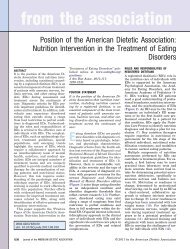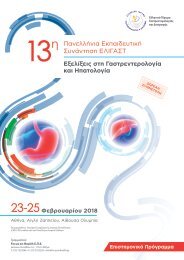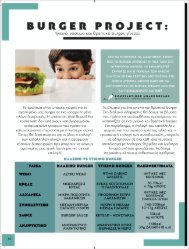Κατευθυντήριες Συστάσεις για την πρόληψη καρδιαγγειακών παθήσεων
www.mednutrition.gr
www.mednutrition.gr
Create successful ePaper yourself
Turn your PDF publications into a flip-book with our unique Google optimized e-Paper software.
Instructions to Authors<br />
of the statistical criteria used. In the next chapter the<br />
results should be presented fully but briefly. Results<br />
shown in tables should not be repeated in the text. In<br />
the Discussion, the perspectives opened up by the results<br />
of the study as well as the final conclusions are<br />
discussed. The results must not be repeated in this section.<br />
A comparison with the results of other similar<br />
studies may be done. The results may also be related<br />
to the objectives of the study but it is advisable to avoid<br />
arbitrary conclusions, not emerging from the results<br />
themselves. Acknowledgements. They are addressed<br />
only to persons who have contributed substantially.<br />
References: They are numbered in the order in which<br />
they are first cited in the text. (e.g. Infl ammation is an<br />
independent risk factor for atherosclerosis. 1). If author<br />
names are cited in the text, first author’s surname<br />
is followed by et al. If there are only two authors, place<br />
an “and” between the two surnames. All references<br />
cited in the text -and those only- must be shown in the<br />
reference section. (e.g. 1. Libby P, Ridker PM, Maseri<br />
A. Infl ammation and atherosclerosis. Circulation 2002,<br />
105:1135-1143).<br />
The number of references must be limited to those<br />
absolutely necessary. Reviews must have no more than<br />
100 references, current issues and editorials up to 10<br />
articles or monographs considered by the author to be<br />
necessary for complete information on the subject, and<br />
letters to the Editor up to 5 references. The reference<br />
section is organized numerically based on the consecutive<br />
numbers and order of references in the text. Cite<br />
the surnames and initials of all authors up to 3 (if more,<br />
add et al after the third), the title of the article, the abbreviation<br />
of journal title, the year, volume, first and<br />
last page of the publication; e.g. You CH, Lee KY, Chey<br />
WY et al. The role of oxidative stress in atherosclerosis.<br />
Circulation 1980, 79:311–314. In case that no author<br />
name is given, cite Anonymous; e.g. Anonymous. Coffee<br />
drinking and atherosclerosis (Editorial). Br Med J<br />
1981, 283:628-629. References of papers published in<br />
supplements, must also note the number of supplement<br />
in parenthesis after the volume, e.g. Eur Heart<br />
Journal 1996, 54(Suppl 1):26-27.<br />
The abbreviations of journal titles must be compatible<br />
to Index Medicus. No full stops are placed after<br />
author acronyms and journal abbreviations. For<br />
books or monographs, list the surnames and initials<br />
of the authors, the title, and the number of edition,<br />
the editor, and the town of edition, the year and the<br />
pages cited. For chapter in a book, the reference must<br />
be written as follows: Papathanasiou IB. Pleiotropic<br />
actions of statins. In: Hypolipidemic drugs in atherosclerosis.<br />
BETA, Athens, 1983:67-113. If the reference<br />
consists of chapter in a book written by another author,<br />
it must be written as follows: Κuhn L, Swartz<br />
MN. Toll-like receptors. In: Lee WA (Ed) or (Eds) Infl<br />
ammation and Atherosclerosis. Saunders, Philadelphia,<br />
1987:457-472. Unpublished material as well as personal<br />
communications should not be used as references,<br />
whereas articles accepted for publication but<br />
not yet published may be included. In this last case<br />
after the journal title abbreviation there should be an<br />
indication “to be published”. Citation of Greek references<br />
is mandatory. Greek literature can be sought<br />
at the Data Base of the Greek Medical Literature<br />
(IATROTEK), www.iatrotek.org.<br />
Chapter numbering in reviews and current issues.<br />
All chapters must be numbered with Arabic numbers<br />
1, 2, 3 etc. Subchapters should have the number of the<br />
initial chapter, point and the number of the subchapter,<br />
e.g. 1.1., 1.2. or 1.1.1., 1.2.1. etc.<br />
Tables: They are typed double-space, in a separate<br />
page. They are numbered by the order they appear<br />
in the text, with Arabic numbers. They should have<br />
a brief, comprehensive explanation so that the reader<br />
need not turn to the text. Each column must have<br />
a brief explanatory heading. Explanations of the abbreviations<br />
should be made at the bottom of the table.<br />
Figures: If your electronic artwork is created in a Microsoft<br />
Office application (Word, PowerPoint, Excel)<br />
then please supply ‘as is’ in the native document format.<br />
Regardless of the application used other than Microsoft<br />
Office, when your electronic artwork is finalized,<br />
please ‘Save as’ or convert the images to one of<br />
the following formats (note the resolution requirements<br />
for line drawings, halftones, and line/halftone<br />
combinations given below): PDF or JPEG.
















